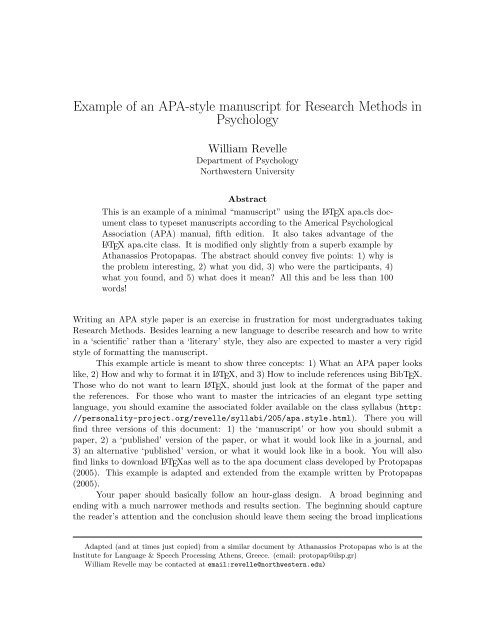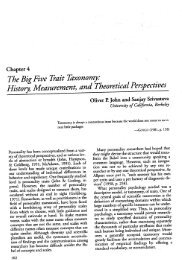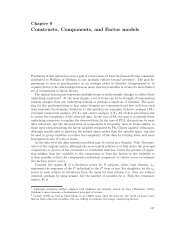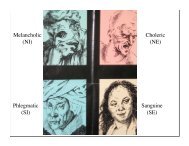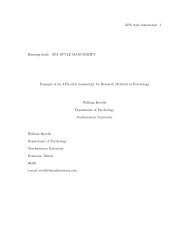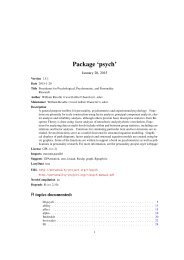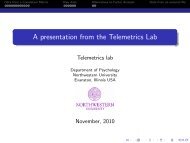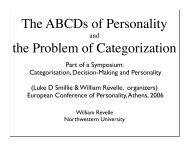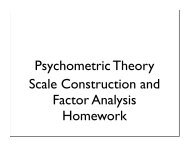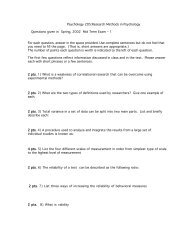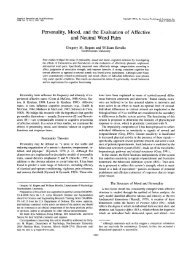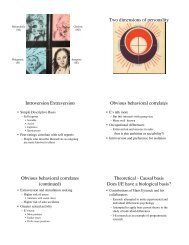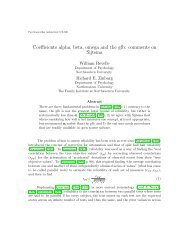Example of an APA-style manuscript for Research Methods in ...
Example of an APA-style manuscript for Research Methods in ...
Example of an APA-style manuscript for Research Methods in ...
- No tags were found...
Create successful ePaper yourself
Turn your PDF publications into a flip-book with our unique Google optimized e-Paper software.
<strong>APA</strong> STYLE MANUSCRIPT 2<strong>of</strong> your study.Follow<strong>in</strong>g the hour glass metaphor, your first few paragraphs should be broad enoughthat someone who knows noth<strong>in</strong>g about the problem will become <strong>in</strong>terested <strong>an</strong>d w<strong>an</strong>t tolearn more. These first two paragraphs are vital, <strong>for</strong> if the reader looks at them <strong>an</strong>d is notexcited, the rest <strong>of</strong> the paper will not be read. The next few paragraphs are aimed at thereader who already knows someth<strong>in</strong>g about the research area <strong>an</strong>d w<strong>an</strong>ts to know why thisparticular paper is worth read<strong>in</strong>g.This first section <strong>of</strong> the article is typically the <strong>in</strong>troduction <strong>an</strong>d, accord<strong>in</strong>g to <strong>APA</strong><strong>style</strong>, should not bear a section head<strong>in</strong>g. 1 Subsequent sections, however, are titled accord<strong>in</strong>gto the psychological conventions.After several paragraphs <strong>of</strong> <strong>in</strong>troduction to your research problem, it is useful to give<strong>an</strong> overview <strong>of</strong> the specific questions you are address<strong>in</strong>g.It is very import<strong>an</strong>t to compare the ‘m<strong>an</strong>uscript’ version <strong>of</strong> this document with thef<strong>in</strong>al ‘journal’ view. Us<strong>in</strong>g L A TEXwe c<strong>an</strong> go back <strong>an</strong>d <strong>for</strong>th between these two <strong>for</strong>mats withease. Tables <strong>an</strong>d Figures need to appear at the end <strong>of</strong> the m<strong>an</strong>uscript version, even thoughthey appear embedded <strong>in</strong> the middle <strong>of</strong> the pr<strong>in</strong>ted version.Experiment 1M<strong>an</strong>uscripts <strong>in</strong> <strong>APA</strong> <strong>style</strong> <strong>of</strong>ten conta<strong>in</strong> descriptions <strong>of</strong> experiments. The <strong>APA</strong> m<strong>an</strong>ualspecifications <strong>for</strong> referr<strong>in</strong>g to experiments are to use a lowercase “e” when speak<strong>in</strong>g generally,as <strong>in</strong> the previous phrase, but <strong>an</strong> uppercase “E” when mention<strong>in</strong>g a particular experiment(as <strong>in</strong> the follow<strong>in</strong>g phrase), such as Experiment 1.MethodThe “method” is a subsection <strong>of</strong> the experimental presentation <strong>in</strong> which all the details<strong>of</strong> sett<strong>in</strong>g up <strong>an</strong>d conduct<strong>in</strong>g the experiment are described. There are a number <strong>of</strong> more orless st<strong>an</strong>dard components to a method, shown below.Particip<strong>an</strong>ts. Psychological experiments are conducted with particip<strong>an</strong>ts, usually hum<strong>an</strong>s.Note that these used to be called “subjects” but apparently <strong>APA</strong> now f<strong>in</strong>ds it<strong>in</strong>appropriate to refer to people with this term. Here we mention how m<strong>an</strong>y particip<strong>an</strong>tsthere were, their ages <strong>an</strong>d other <strong>in</strong><strong>for</strong>mation about them. In particular, how m<strong>an</strong>y weremale <strong>an</strong>d how m<strong>an</strong>y were female. How were they chosen?Apparatus. Sometimes it is necessary to give the apparatus a special section. Thissection c<strong>an</strong> also be called ‘Materials’.The dist<strong>in</strong>ction between materials/apparatus <strong>an</strong>d procedure may be thought <strong>of</strong> <strong>in</strong>terms <strong>of</strong> hav<strong>in</strong>g two research assist<strong>an</strong>ts. One gets the materials ready, the second runsthe particip<strong>an</strong>ts. Everyth<strong>in</strong>g that assist<strong>an</strong>t 1 needs to get ready should be <strong>in</strong> materials/apparatus,everyth<strong>in</strong>g that assist<strong>an</strong>t 2 needs to do is <strong>in</strong> procedure. There should be nosurprises! Assist<strong>an</strong>t 2 should not be told to create a new questionnaire, this should havebeen done by Assist<strong>an</strong>t 1.1 That is, there is no “Introduction” section.
<strong>APA</strong> STYLE MANUSCRIPT 3Stimuli. What the subjects saw, heard, or felt. Usually stimuli are part <strong>of</strong> the materialsor apparatus, but if do<strong>in</strong>g a psychophysics study, it is import<strong>an</strong>t to describe how thestimuli were generated <strong>an</strong>d <strong>in</strong>clude such detail as screen decay rate <strong>an</strong>d visual <strong>an</strong>gle.Procedure. What was done to the subjects. This should be detailed enough thatsomeone else could run the study follow<strong>in</strong>g the procedures section.ResultsIn this subsection, one shows numbers <strong>an</strong>d statistical <strong>an</strong>alyses. Seasoned researchers<strong>of</strong>ten avoid read<strong>in</strong>g the results section <strong>in</strong> the first read<strong>in</strong>g, especially if the article is not <strong>of</strong>particular <strong>in</strong>terest <strong>for</strong> their own research.Results should be stated first <strong>in</strong> words, then numbers, <strong>an</strong>d then statistics. E.g.,particip<strong>an</strong>ts <strong>in</strong> the relaxed condition (M= 5.1, sd = 1.66) did better th<strong>an</strong> those <strong>in</strong> thestressed condition (M=2.8, sd = 1.93), t(38) = 2.85, p < .05, p-rep = .96.Note that the use <strong>of</strong> the p-rep (probability <strong>of</strong> a replication) statistic (Killeen, 2005)is now required by articles submitted to Psychological Science. This reflects a generalappreciation that what is import<strong>an</strong>t is not rejection <strong>of</strong> the hypothesis that groups do notdiffer but rather <strong>an</strong> estimate <strong>of</strong> the particular parameter <strong>of</strong> <strong>in</strong>terest. (We do not say thatthe speed <strong>of</strong> light is not zero, we care about what it is, <strong>an</strong>d with what error <strong>of</strong> estimate.)The p-rep statistic is a beg<strong>in</strong>n<strong>in</strong>g <strong>of</strong> this movement, <strong>for</strong> it <strong>for</strong>ces us to th<strong>in</strong>k about theprobability <strong>of</strong> gett<strong>in</strong>g a result <strong>in</strong> the same direction if we do the study aga<strong>in</strong>. P-rep may becalculated us<strong>in</strong>g the p.rep function <strong>in</strong> the psych package <strong>in</strong> R (R Development Core Team,2007).We c<strong>an</strong> also <strong>in</strong>clude a figure to show results graphically (Figure 1). Without us<strong>in</strong>gL A TEXjust <strong>in</strong>clude the figure(s) as the last page(s) <strong>of</strong> the m<strong>an</strong>uscript. However, if you w<strong>an</strong>tto try L A TEX, there are two ways <strong>of</strong> do<strong>in</strong>g this: use the normal <strong>in</strong>cludegraphics comm<strong>an</strong>d,or use the fitfigure comm<strong>an</strong>d that comes with apa.cls. The later technique scales thefigure to fit one or two columns.DiscussionIf the results <strong>of</strong> the experiment me<strong>an</strong> <strong>an</strong>yth<strong>in</strong>g, this is the place to talk about it. Ifthis is a two study paper, then this discussion is just about Experiment 1. No new numbersshould appear <strong>in</strong> the discussion section. If you w<strong>an</strong>t to <strong>in</strong>troduce a number, do it <strong>in</strong> theresults section.Experiment 2Usually one experiment is not enough to conv<strong>in</strong>ce <strong>an</strong>yone; you need additional controlexperiments to make your po<strong>in</strong>t. Indeed, some articles will <strong>in</strong>clude m<strong>an</strong>y different experiments.The <strong>in</strong>troduction to experiment 2 could discuss what is miss<strong>in</strong>g from experiment 1<strong>an</strong>d how experiment 2 addresses the problem.MethodThe method c<strong>an</strong> be the same as <strong>for</strong> the previous experiment, s<strong>in</strong>ce here we are simply<strong>in</strong>terested <strong>in</strong> show<strong>in</strong>g the structure <strong>of</strong> the m<strong>an</strong>uscript. If the methods do differ from Study1 to Study 2, highlight how they differ.
<strong>APA</strong> STYLE MANUSCRIPT 4A double dissociationDependent Variable0.0 0.2 0.4 0.6 0.8 1.0IV 2 = 2IV 2 = 11 2Independent VariableFigure 1. Figure captions go below the figure when pr<strong>in</strong>ted, but on a separate page <strong>in</strong> them<strong>an</strong>uscript. To allow it to fit <strong>in</strong> a two column <strong>for</strong>mat (i.e., us<strong>in</strong>g the jou option <strong>in</strong> L A TEX) <strong>an</strong>dus<strong>in</strong>g the <strong>in</strong>sertgraphics comm<strong>an</strong>d, it is necessary to make the figure no bigger th<strong>an</strong> 275 x 275pixels. This figure was generated us<strong>in</strong>g the R statistics <strong>an</strong>d graphics program.
<strong>APA</strong> STYLE MANUSCRIPT 5normal(0,1)-3 -1 1 3X1 X2 X3 X4 X5 X6 X7 X8 X9 X10normal(0,1) + 10% normal(0,2)-4 -2 0 2X1 X2 X3 X4 X5 X6 X7 X8 X9 X10Figure 2. Alternatively, the figure c<strong>an</strong> be made a large figure by us<strong>in</strong>g the figure* comm<strong>an</strong>d. Thisfigure was generated us<strong>in</strong>g the R statistics <strong>an</strong>d graphics program. This is a demonstration <strong>of</strong> a‘notched boxplot’ <strong>for</strong> ten samples taken from a normal distribution, <strong>an</strong>d ten taken from a mixture<strong>of</strong> two normals with different vari<strong>an</strong>ces.
<strong>APA</strong> STYLE MANUSCRIPT 6Table 1: Some numbers that could be experimental data.Factor 2Factor 1 Condition A Condition BFirst 586 (231) 649 (255)2.2 7.5Second 590 (195) 623 (231)2.8 2.5ResultsThis is a good po<strong>in</strong>t to show <strong>an</strong> example <strong>of</strong> a table follow<strong>in</strong>g <strong>APA</strong> conventions. Notethat we don’t use <strong>an</strong>y vertical separators <strong>an</strong>d that columns c<strong>an</strong> be grouped with partialhorizontal l<strong>in</strong>es. Also keep <strong>in</strong> m<strong>in</strong>d that the caption must precede the table. The label isentirely optional, but useful <strong>for</strong> referr<strong>in</strong>g to the table <strong>in</strong> the text, <strong>for</strong> example this one wouldbe Table 1. One <strong>of</strong> the trickies problems <strong>in</strong> L A TEXis gett<strong>in</strong>g the figure or table to appearroughly where you w<strong>an</strong>t it. This is not a problem <strong>in</strong> the ‘m<strong>an</strong>uscript’ version, <strong>for</strong> all tables<strong>an</strong>d all figures are put at the end. But if you are do<strong>in</strong>g ‘jou’ or ‘doc’ <strong>for</strong>matt<strong>in</strong>g, the tableswill appear at places that a not very clever typesetter would put them, but not where youwould necessarily put them.DiscussionThis is a discussion just <strong>of</strong> the second study.General DiscussionIn psychological articles there is usually some po<strong>in</strong>t to the whole experimental exercise,<strong>an</strong>d <strong>in</strong> the end we get to discuss how import<strong>an</strong>t it all is. Although literature is supposedto have been covered <strong>in</strong> the <strong>in</strong>troduction, <strong>for</strong> this example we c<strong>an</strong> illustrate the use <strong>of</strong>bibliographic citations <strong>in</strong> this f<strong>in</strong>al section. The accomp<strong>an</strong>y<strong>in</strong>g package “apacite” by ErikMeijer provides everyth<strong>in</strong>g <strong>an</strong> <strong>APA</strong>-<strong>style</strong> writer needs <strong>for</strong> citations, such as <strong>in</strong>-text citations<strong>in</strong> which one c<strong>an</strong> claim that (Leary, 2007) mentioned or failed to mention someth<strong>in</strong>g.It is import<strong>an</strong>t to note that books (Leary, 2007) are cited <strong>in</strong> the bibliography differentlyth<strong>an</strong> chapters (Revelle, 2007) or articles (Killeen, 2005). The specific rules <strong>for</strong>citations are complicated, but actually are <strong>in</strong>cluded <strong>in</strong> such bibliographic tools as the opensource <strong>for</strong>mat BibTex (which c<strong>an</strong> be used by L A TEXus<strong>in</strong>g the apa.cite comm<strong>an</strong>ds) or thecommercial program EndNote. For Northwestern students, EndNote may be downloaded<strong>for</strong> personal use. The <strong>of</strong>ficial guide to how to <strong>in</strong>clude references is the <strong>APA</strong> <strong>style</strong> m<strong>an</strong>ual(Americ<strong>an</strong> Psychological Association, 2001), but “cheat sheets” may be found on the webby search<strong>in</strong>g <strong>for</strong> ‘<strong>APA</strong> <strong>style</strong>’.Some import<strong>an</strong>t rules <strong>for</strong> those who choose not to use L A TEX. The m<strong>an</strong>uscript needs tobe double spaced throughout, with ragged right marg<strong>in</strong>s. Tables appear on separate pagesfollow<strong>in</strong>g the References. Then comes a page <strong>of</strong> Figure Captions, then come the figures.Exam<strong>in</strong>e the ‘m<strong>an</strong>uscript’ example on the web page very carefully.
<strong>APA</strong> STYLE MANUSCRIPT 7ReferencesAmeric<strong>an</strong> Psychological Association. (2001). Publication m<strong>an</strong>ual <strong>of</strong> the americ<strong>an</strong> psychologicalassociation (5th ed.). Wash<strong>in</strong>gton, DC: Americ<strong>an</strong> Psychological Association.Killeen, P. (2005). An alternative to null-hypothesis signific<strong>an</strong>ce tests. Psychological Science, 16,345-353.Leary, M. R. (2007). Introduction to behavioral research methods (5 ed.). Needham Heights, Ma.:Allyn <strong>an</strong>d Bacon.Protopapas, A. (2005). <strong>Example</strong> <strong>of</strong> <strong>an</strong> apa-<strong>style</strong> maunscript: a guide to us<strong>in</strong>g apa.cls. RetrievedAugust 20, 2007, from http://www.ilsp.gr/homepages/protopapas/apacls.html.R Development Core Team. (2007). R: A l<strong>an</strong>guage <strong>an</strong>d environment <strong>for</strong> statistical comput<strong>in</strong>g.Vienna, Austria. (ISBN 3-900051-07-0)Revelle, W. (2007). Experimental approaches to the study <strong>of</strong> personality. In R. Rob<strong>in</strong>s, R. C. Fraley,& R. F. Krueger (Eds.), H<strong>an</strong>dbook <strong>of</strong> research methods <strong>in</strong> personality psychology. (p. 37-61).New York: Guil<strong>for</strong>d.


